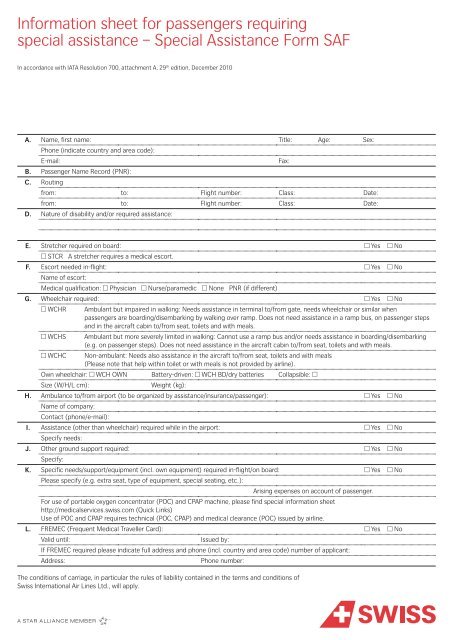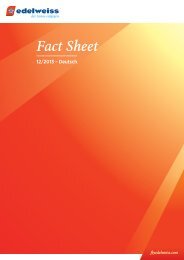SAF/MEDIF form - Swiss
SAF/MEDIF form - Swiss
SAF/MEDIF form - Swiss
Create successful ePaper yourself
Turn your PDF publications into a flip-book with our unique Google optimized e-Paper software.
In<strong>form</strong>ation sheet for passengers requiring<br />
special assistance – Special Assistance Form <strong>SAF</strong><br />
In accordance with IATA Resolution 700, attachment A, 29 th edition, December 2010<br />
A. Name, first name: Title: Age: Sex:<br />
Phone (indicate country and area code):<br />
E-mail:<br />
Fax:<br />
B. Passenger Name Record (PNR):<br />
C. Routing<br />
from: to: Flight number: Class: Date:<br />
from: to: Flight number: Class: Date:<br />
D. Nature of disability and/or required assistance:<br />
E. Stretcher required on board: ~ Yes ~ No<br />
~ STCR A stretcher requires a medical escort.<br />
F. Escort needed in-flight: ~ Yes ~ No<br />
Name of escort:<br />
Medical qualification: ~ Physician ~ Nurse/paramedic ~ None PNR (if different)<br />
G. Wheelchair required: ~ Yes ~ No<br />
~ WCHR Ambulant but impaired in walking: Needs assistance in terminal to/from gate, needs wheelchair or similar when<br />
passengers are boarding/disembarking by walking over ramp. Does not need assistance in a ramp bus, on passenger steps<br />
and in the aircraft cabin to/from seat, toilets and with meals.<br />
~ WCHS Ambulant but more severely limited in walking: Cannot use a ramp bus and/or needs assistance in boarding/disembarking<br />
(e.g. on passenger steps). Does not need assistance in the aircraft cabin to/from seat, toilets and with meals.<br />
~ WCHC Non-ambulant: Needs also assistance in the aircraft to/from seat, toilets and with meals<br />
(Please note that help within toilet or with meals is not provided by airline).<br />
Own wheelchair: ~ WCH OWN Battery-driven: ~ WCH BD/dry batteries Collapsible: ~<br />
Size (W/H/L cm):<br />
Weight (kg):<br />
H. Ambulance to/from airport (to be organized by assistance/insurance/passenger): ~ Yes ~ No<br />
Name of company:<br />
Contact (phone/e-mail):<br />
I. Assistance (other than wheelchair) required while in the airport: ~ Yes ~ No<br />
Specify needs:<br />
J. Other ground support required: ~ Yes ~ No<br />
Specify:<br />
K. Specific needs/support/equipment (incl. own equipment) required in-flight/on board: ~ Yes ~ No<br />
Please specify (e.g. extra seat, type of equipment, special seating, etc.):<br />
Arising expenses on account of passenger.<br />
For use of portable oxygen concentrator (POC) and CPAP machine, please find special in<strong>form</strong>ation sheet<br />
http://medicalservices.swiss.com (Quick Links)<br />
Use of POC and CPAP requires technical (POC, CPAP) and medical clearance (POC) issued by airline.<br />
L. FREMEC (Frequent Medical Traveller Card): ~ Yes ~ No<br />
Valid until:<br />
Issued by:<br />
If FREMEC required please indicate full address and phone (incl. country and area code) number of applicant:<br />
Address:<br />
Phone number:<br />
The conditions of carriage, in particular the rules of liability contained in the terms and conditions of<br />
<strong>Swiss</strong> International Air Lines Ltd., will apply.
In<strong>form</strong>ation sheet for passengers requiring<br />
Medical Clearance – <strong>MEDIF</strong>, part one<br />
In accordance with IATA Resolution 700, attachment A, 29 th edition, December 2010<br />
Note for the attending physician:<br />
The details requested in here will be treated confidentially; they should enable the Medical Services of the airline(s), as it is their obligation, to judge<br />
by their specific air medical knowledge and experience if and under what conditions the patient can be permitted to travel by aircraft as requested.<br />
These details will also help the Medical Service in issuing appropriate instructions for the patient’s care which duly consider both his/her diagnosis and<br />
the special circumstances of the requested air journey. Kindly answer all questions by cross or in block letters, as necessary. Please fill in this <strong>form</strong> on<br />
your PC to enhance readability and clarity. You can easily typewrite into the grey fields. Thank you for your cooperation!<br />
1. Patient<br />
Name, first name:<br />
Date of birth: Sex: Height: Weight:<br />
2. Attending physician<br />
Name:<br />
Address:<br />
Phone:<br />
E-Mail:<br />
Fax:<br />
3. Diagnosis (including short history, onset of current illness, episode or accident and treatment, specify if contagious)<br />
Nature and date of any recent and/or relevant surgery:<br />
4. Current symptoms and severity Date of onset:<br />
5. Will a 25% to 30% reduction in the ambient partial pressure of oxygen (relative hypoxia) affect the passenger’s medical condition? (Cabin<br />
pressure to be the equivalent of a fast trip to a mountain elevation of 2,400 meters (8,000 feet) above sea level)<br />
~ Yes ~ No ~ Not sure<br />
6. Supplementary in<strong>form</strong>ation<br />
Anaemia: ~ Yes ~ No If yes, give date: and result of<br />
recent haemoglobin analysis gm/dl<br />
Psychiatric conditions: ~ Yes ~ No If yes, see Part 2<br />
Cardiac disorder: ~ Yes ~ No If yes, see Part 2<br />
Normal bladder control: ~ Yes ~ No If no, give mode of control:<br />
Normal bowel control: ~ Yes ~ No<br />
Respiratory disorder: ~ Yes ~ No If yes, see Part 2<br />
Does the patient require oxygen at home? ~ Yes ~ No If yes, specify how much l/min (LPM):<br />
Oxygen needed during flight? ~ Yes ~ No If yes, specify, ~ 2 l/min ~ 4 l/min<br />
Seizure disorder: ~ Yes ~ No If yes, see Part 2<br />
7. Escort<br />
Is the patient fit to travel unaccompanied? ~ Yes ~ No<br />
If no, would a meet-and-assist (provided by the airline to embark and disembark) be sufficient? ~ Yes ~ No<br />
If no, will the patient have a private escort to take care of his/her needs on board? ~ Yes ~ No<br />
If yes, who should escort the passenger? ~ Doctor ~ Nurse/Paramedic ~ Other<br />
If other, is the escort fully capable to attend to all above mentioned needs? ~ Yes ~ No<br />
Is the patient able to sit in a usual aircraft seat (seatback in upright position)? ~ Yes ~ No<br />
8. Mobility<br />
able to walk without assistance: ~ Yes ~ No Wheelchair required for boarding: ~ to aircraft ~ to seat<br />
9. Medication list (incl. doses):<br />
10. Other medical in<strong>form</strong>ation:
In<strong>form</strong>ation sheet for passengers requiring<br />
Medical Clearance – <strong>MEDIF</strong>, part two<br />
In accordance with IATA Resolution 700, attachment A, 29 th edition, December 2010<br />
1. Cardiac condition: ~ Yes ~ No<br />
Angina: ~ Yes ~ No When was last episode?<br />
– Is the condition stable? ~ Yes ~ No<br />
– Functional class of the patient? (CSS) ~ Angina with strenuous activity ~ with moderate activity<br />
~ with mild activity ~ with rest or minimal activity<br />
– Can the patient walk 100 metres at a normal pace or climb 10–12 stairs without symptoms? ~ Yes ~ No<br />
Myocardial infarction: ~ Yes ~ No Date:<br />
– Complications? ~ Yes ~ No If yes, give details:<br />
– Stress EKG done? ~ Yes ~ No If yes, what was the result? MET’s or Watt<br />
– If angioplasty or coronary bypass, can patient walk 100 yards/metres<br />
at a normal pace or climb 10–12 stairs without symptoms? ~ Yes ~ No<br />
Cardiac failure: ~ Yes ~ No When was last episode?<br />
– Is the patient controlled with medication? ~ Yes ~ No<br />
– Functional class of the patient? ~ No symptoms ~ Shortness of breath (SOB) with moderate exertion<br />
~ SOB with minimal exertion ~ Shortness of breath at rest<br />
Syncope: ~ Yes ~ No When was last episode?<br />
– Investigations: ~ Yes ~ No If yes, state results?<br />
2. Chronic pulmonary condition: ~ Yes ~ No<br />
Has the patient had recent arterial blood gases? ~ Yes ~ No<br />
Blood gases were taken on ~ Room air ~ Oxygen Litres per minute (LPM)<br />
– If yes, what were the results? pCO 2 [kPa/mmHg] pO 2 [kPa/mmHg]<br />
% Saturation Date of exam:<br />
Does the patient retain CO 2 ? ~ Yes ~ No<br />
Has his/her condition deteriorated recently? ~ Yes ~ No<br />
Can patient walk 100 yards/metres at a normal pace or climb 10–12 stairs without symptoms? ~ Yes ~ No<br />
Has the patient ever taken a commercial aircraft in his/her current medical status? ~ Yes ~ No<br />
– If yes, when?<br />
– Did the patient have any problems?<br />
3. Psychiatric conditions: ~ Yes ~ No<br />
Is there a possibility that the patient will become agitated during flight? ~ Yes ~ No<br />
Has he/she taken a commercial aircraft before? ~ Yes ~ No<br />
– If yes, date of travel? Did the patient travel: ~ alone ~ escorted?<br />
4. Seizure: ~ Yes ~ No<br />
What type of seizures?<br />
Frequency of the seizures:<br />
When was the last seizure?<br />
Are the seizures controlled by medication? ~ Yes ~ No<br />
5. Prognosis for the trip: ~ Good ~ Poor<br />
Signature of physician (or facsimile):<br />
Date:<br />
Note: Cabin attendants are not authorized to give special assistance (e.g. lifting, meals) to particular passengers, to the detriment of their service to other passengers. Additionally, they are trained only in first aid and<br />
are not permitted to administer any injection, or give medication. Important: Fees, if any, relevant to the provision of the above in<strong>form</strong>ation and for carrier-provided special equipment are to be paid by the passenger<br />
concerned.







